Fuel cells offer higher energy efficiency, converting 40-60% of input to electricity compared to 22-23% for the best solar panels. They're less weather-dependent, providing consistent power 24/7 regardless of conditions. You'll need less space for installation, and they can be placed indoors or in compact outdoor enclosures. While initial costs are higher, fuel cells promise significant long-term savings with a 20-30 year lifespan and lower maintenance needs. They also provide reliable energy storage without additional batteries. Despite these advantages, your choice should consider local resources and specific energy needs. There's more to uncover about these competing technologies.
Energy Efficiency Comparison
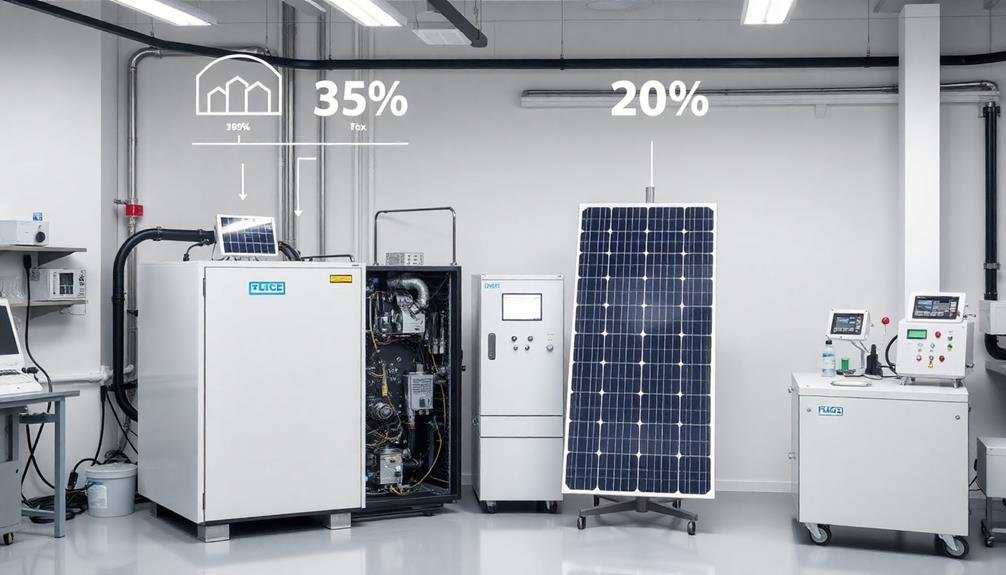
Efficiency lies at the heart of comparing fuel cells and photovoltaic systems. When you're evaluating which technology to choose, it's essential to understand how each converts energy and their overall performance.
Fuel cells typically boast higher energy conversion efficiencies than photovoltaic (PV) systems. While the best commercial PV panels reach about 22-23% efficiency, fuel cells can achieve efficiencies of 40-60% in electricity generation. This means fuel cells convert a larger portion of their energy input into usable electricity.
However, it's not just about raw efficiency numbers. You'll need to examine the entire energy chain. PV systems directly convert sunlight into electricity, while fuel cells require hydrogen production and storage. This additional step in the fuel cell process can impact overall system efficiency.
PV systems' performance varies with sunlight availability and weather conditions. Fuel cells, on the other hand, can provide consistent power output as long as fuel is supplied. This reliability factor might outweigh pure efficiency evaluations in certain applications where constant power is critical.
Space Requirements and Installation
Beyond efficiency factors, you'll need to think about the physical footprint and installation process for both fuel cells and photovoltaic systems.
Fuel cells typically require less space than photovoltaic arrays, making them ideal for areas with limited room. You can often install fuel cells indoors or in compact outdoor enclosures, while solar panels need considerable roof or ground space with unobstructed sun exposure.
Installation of fuel cells is generally simpler and faster. They don't require complex mounting systems or extensive wiring. You'll mainly need to connect the fuel source, such as natural gas or hydrogen, and the electrical output.
Photovoltaic systems, however, involve mounting multiple panels, installing inverters, and integrating with your existing electrical system.
Weather and location impact photovoltaic installations more notably. You'll need to take into account factors like roof angle, shading, and local climate when planning a solar array.
Fuel cells aren't affected by these variables, offering more flexibility in placement. However, you'll need to confirm a reliable fuel supply and proper ventilation for fuel cells, which isn't a concern with solar panels.
Weather Dependency and Reliability
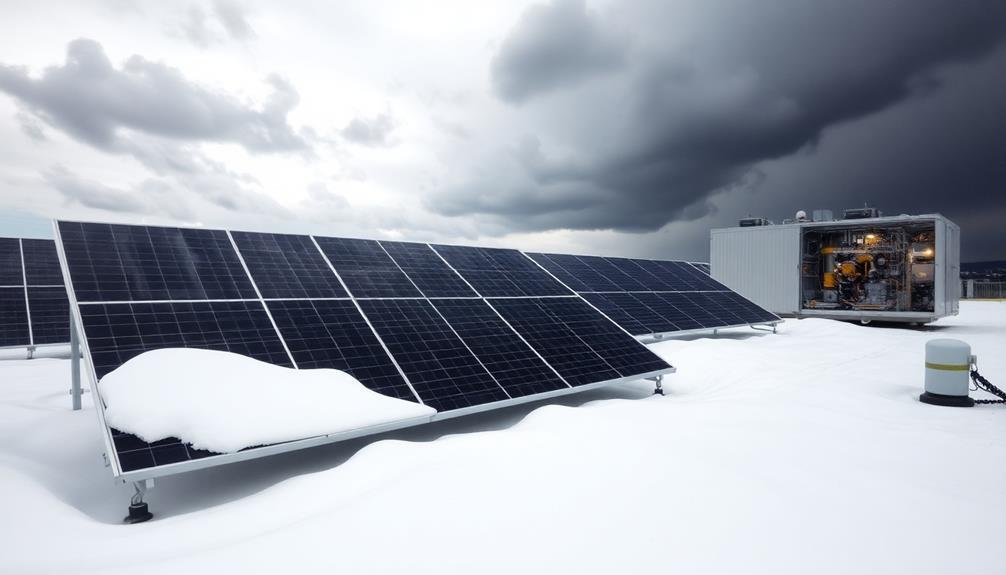
Weather plays a considerable role in the performance of photovoltaic systems, while fuel cells remain largely unaffected by atmospheric conditions. You'll find that solar panels' efficiency drops considerably during cloudy or rainy days, and they don't generate electricity at night.
In contrast, fuel cells operate consistently regardless of weather, providing a reliable power source 24/7.
When considering reliability, fuel cells have a clear advantage. They don't suffer from the intermittency issues that plague solar power. You can count on fuel cells to deliver a steady stream of electricity, making them ideal for critical applications where continuous power is essential.
To illustrate the weather dependency of photovoltaic systems, imagine:
- A solar farm on a foggy morning, barely producing any power
- Snow-covered panels in winter, rendering them useless
- Dust storms reducing efficiency in desert installations
- Tropical storms damaging exposed solar arrays
These scenarios highlight the vulnerability of photovoltaic systems to environmental factors. Fuel cells, housed in protected enclosures, aren't subject to these risks.
They'll continue functioning efficiently in various weather conditions, ensuring you have a dependable power supply year-round.
Initial Costs and Long-Term Savings
While weather and reliability are key factors, the financial aspect of choosing between fuel cells and photovoltaic systems can't be overlooked. When considering initial costs, you'll find that photovoltaic systems generally have a lower upfront investment. Fuel cells, on the other hand, tend to have higher initial costs due to their complex technology and limited mass production.
However, don't let the initial price tag deter you from fuel cells. In the long run, they can offer significant savings. Fuel cells have a longer lifespan, often lasting 20-30 years compared to the 15-25 years of photovoltaic panels. They also require less maintenance, which translates to lower operational costs over time.
Fuel cells' efficiency in converting fuel to electricity is typically higher than photovoltaic systems, especially in varying weather conditions. This means you'll generate more power consistently, potentially leading to greater energy savings. Additionally, fuel cells can operate continuously, providing a steady power supply without the need for energy storage systems, which are often required with photovoltaic setups.
Consider your long-term energy needs and financial goals when weighing these options. While photovoltaics might seem more affordable initially, fuel cells could prove more cost-effective in the long run.
Environmental Impact Assessment
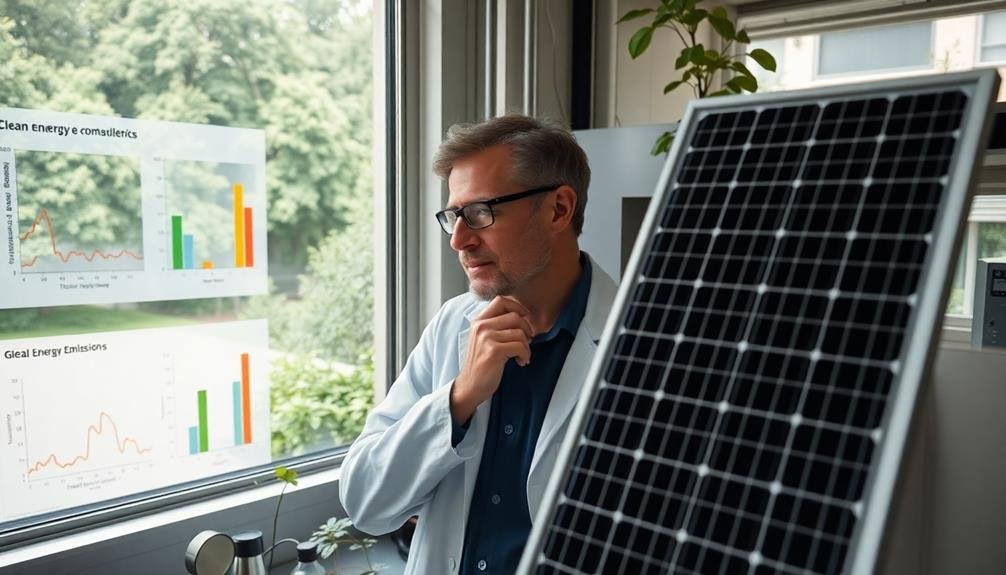
When comparing fuel cells and photovoltaic systems, you'll find significant differences in their environmental impacts.
You'll notice that both technologies reduce emissions and pollutants compared to traditional energy sources, but photovoltaic systems generally have a lower overall environmental footprint.
You'll want to evaluate the resource consumption of each technology, including manufacturing processes and raw materials used, to get a thorough view of their environmental effects.
Emissions and Pollutant Reduction
Concerning environmental impact, both fuel cells and photovoltaic systems offer considerable advantages over conventional energy sources. When you're considering emissions and pollutant reduction, fuel cells have a slight edge over photovoltaic systems.
Fuel cells produce electricity through a chemical reaction, typically combining hydrogen and oxygen. This process results in minimal emissions, with water vapor being the primary byproduct. On the other hand, photovoltaic systems generate electricity directly from sunlight, producing no emissions during operation.
While both technologies notably reduce pollutants compared to fossil fuels, fuel cells can provide additional benefits:
- Reduced noise pollution, as they operate silently
- Lower heat generation, minimizing urban heat island effects
- Potential for carbon-negative operation when using renewable hydrogen sources
- Ability to capture and reuse waste heat for increased efficiency
It's important to note that the overall environmental impact of fuel cells depends on the source of hydrogen. When produced from renewable sources, fuel cells can offer a nearly zero-emission energy solution.
Photovoltaic systems, while clean during operation, may have some environmental impact during manufacturing and disposal of panels.
Resource Consumption Comparison
Examining resource consumption offers another critical lens for comparing fuel cells and photovoltaic systems. When you're considering these technologies, it's crucial to look at their entire lifecycle impact on natural resources.
Fuel cells primarily rely on hydrogen, which can be produced from various sources, including renewable ones. They require fewer raw materials in their construction compared to solar panels. However, the production of hydrogen can be energy-intensive, depending on the method used.
Photovoltaic systems, on the other hand, demand significant resources during manufacturing, particularly rare earth elements and metals like silver. They also require large land areas for installation, which can impact local ecosystems.
However, once installed, they've minimal resource consumption over their operational lifetime.
You'll find that fuel cells have a smaller physical footprint and can be more easily integrated into existing infrastructure. They also have a longer lifespan and maintain higher efficiency throughout their use. In contrast, solar panels gradually degrade over time, requiring more frequent replacement.
Ultimately, your choice between these technologies should consider local resource availability, long-term sustainability, and the specific energy needs of your application.
Maintenance and Lifespan Considerations
Fuel cells' and photovoltaic systems' maintenance requirements and lifespans play vital roles in their long-term viability and cost-effectiveness.
When considering maintenance, fuel cells typically require more frequent attention due to their complex components and the presence of moving parts. You'll need to replace catalysts and membranes periodically, which can be costly.
On the other hand, photovoltaic systems have fewer moving parts and generally require less maintenance, mainly consisting of cleaning and occasional inverter replacements.
Regarding lifespan, photovoltaic systems often have the edge. Most solar panels come with 25-30 year warranties and can last even longer. Fuel cells, however, may need replacement after 5-15 years, depending on usage and technology.
To visualize the maintenance aspects, consider these points:
- Fuel cell stack replacement every 5-7 years
- Solar panel cleaning 2-4 times per year
- Fuel cell catalyst regeneration annually
- Inverter replacement for solar systems every 10-15 years
While fuel cells may require more frequent maintenance, they offer advantages in certain applications where continuous power generation is significant.
Your choice between the two technologies should consider these maintenance and lifespan factors alongside your specific energy needs and environmental conditions.
Energy Storage Capabilities
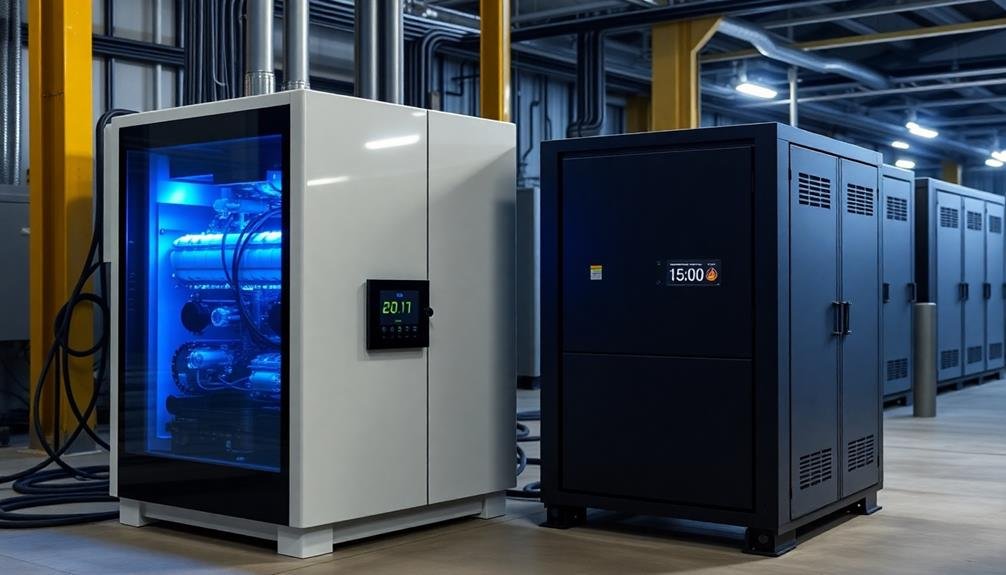
When comparing fuel cells and photovoltaic systems, you'll find significant differences in their energy storage capabilities.
Fuel cells offer long-term power retention, allowing you to store energy for extended periods without substantial loss. This consistent energy availability means you can rely on fuel cells for steady power output, even during prolonged periods without sunlight or in locations with variable weather conditions.
Long-Term Power Retention
Storing energy for extended periods is an essential factor when comparing fuel cells and photovoltaic systems. When it comes to long-term power retention, fuel cells have a distinct advantage. They can store energy in the form of hydrogen for months or even years without significant loss, making them ideal for backup power systems and remote locations.
In contrast, photovoltaic systems rely on batteries for energy storage, which can suffer from self-discharge and capacity degradation over time. This means you'll need to regularly maintain and replace batteries to guarantee reliable long-term power retention.
To visualize the long-term power retention capabilities of fuel cells, imagine:
- A remote weather station operating continuously for years without maintenance
- A backup power system ready to kick in after months of inactivity
- An off-grid home with consistent power through changing seasons
- A spacecraft utilizing stored hydrogen for deep space missions
Fuel cells' ability to retain power for extended periods makes them a more dependable choice for applications requiring long-term energy storage.
You'll benefit from reduced maintenance costs and increased reliability, especially in situations where consistent power availability is critical.
Consistent Energy Availability
Despite their differences, both fuel cells and photovoltaic systems aim to provide consistent energy availability. However, fuel cells have a distinct advantage in this area. Unlike solar panels, which rely on sunlight, fuel cells can operate continuously as long as they've a fuel supply.
You'll find that fuel cells offer more reliable power generation, especially in regions with limited sunlight or during nighttime hours. They can produce electricity on-demand, regardless of weather conditions or time of day. This consistent energy availability makes fuel cells particularly valuable for critical applications, such as backup power systems or remote locations where grid access is unreliable.
In contrast, photovoltaic systems require energy storage solutions, like batteries, to provide power when sunlight isn't available. While battery technology has improved, it still faces limitations in capacity and lifespan.
Fuel cells, on the other hand, can be quickly refueled, allowing for extended operation without the need for long charging periods.
Fuel Availability and Infrastructure
The lifeblood of fuel cells, hydrogen, faces significant hurdles in availability and infrastructure relative to solar energy for photovoltaic systems. While sunlight is freely available, hydrogen production and distribution require substantial investment and planning.
You'll find that the current hydrogen infrastructure is limited, primarily serving industrial applications rather than widespread consumer use.
To visualize the challenges of hydrogen infrastructure, consider these key elements:
- Hydrogen production facilities
- Storage tanks and compression systems
- Specialized transportation vehicles
- Fueling stations with high-pressure dispensers
Despite these obstacles, progress is being made. You're seeing increased investment in hydrogen production, including green hydrogen from renewable sources. As demand grows, infrastructure will expand, making fuel cells more viable for various applications.
However, you should note that photovoltaic systems have a significant head start regarding infrastructure. Solar panels can be easily installed on existing structures, and the electrical grid already supports their integration.
This advantage allows for quicker adoption and lower initial costs compared to fuel cells, which require a more extensive overhaul of energy infrastructure.
Frequently Asked Questions
How Do Fuel Cells Compare to Other Alternative Energy Sources Besides Photovoltaic Systems?
You'll find fuel cells offer unique advantages compared to other alternative energy sources. They're more efficient than wind turbines, more reliable than geothermal, and can produce power 24/7 unlike solar. They're also portable and scalable.
Can Fuel Cells Be Used in Residential Settings or Only Industrial Applications?
You can use fuel cells in your home, not just in industry. They'll provide reliable power for your house, heating, and even your car. Residential fuel cell systems are becoming more affordable and efficient for everyday consumers.
What Safety Considerations Are Associated With Using Fuel Cell Technology?
You'll need to contemplate gas leakage risks, proper ventilation, and potential fire hazards when using fuel cells. They require careful handling of hydrogen and regular maintenance. Always follow manufacturer's guidelines and local safety regulations for safe operation.
How Quickly Can Fuel Cell Systems Be Scaled up for Increased Energy Demand?
You can scale up fuel cell systems relatively quickly. They're modular, so you'll add more units to increase capacity. With proper planning, you can expand your system in weeks or months, depending on the scale of your project.
Are There Any Government Incentives or Tax Benefits for Adopting Fuel Cell Technology?
Yes, you'll find various government incentives for fuel cell adoption. These often include tax credits, grants, and rebates at federal, state, and local levels. Check with your local energy office for specific programs available in your area.
In Summary
You've seen the pros and cons of fuel cells and photovoltaic systems. While solar panels are more common, fuel cells offer unique advantages in reliability, space efficiency, and consistent power output. Your choice depends on your specific needs, location, and budget. Consider factors like weather patterns, available space, and local energy infrastructure. Ultimately, both technologies contribute to a greener future, so you're making a positive impact whichever you choose. Weigh your options carefully to make the best decision for your situation.

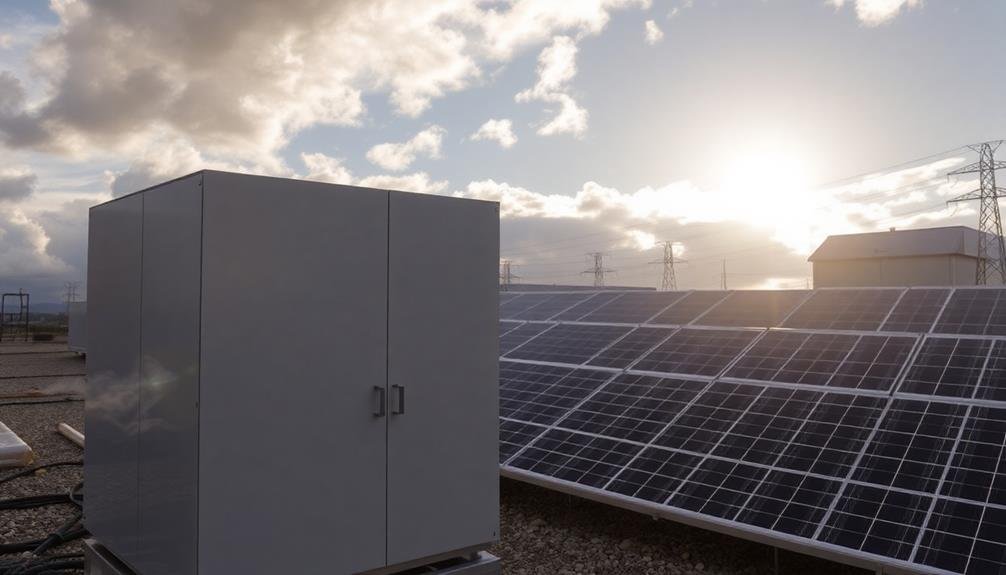



Leave a Reply